Check Our Risk-Free Booking Policy View Details
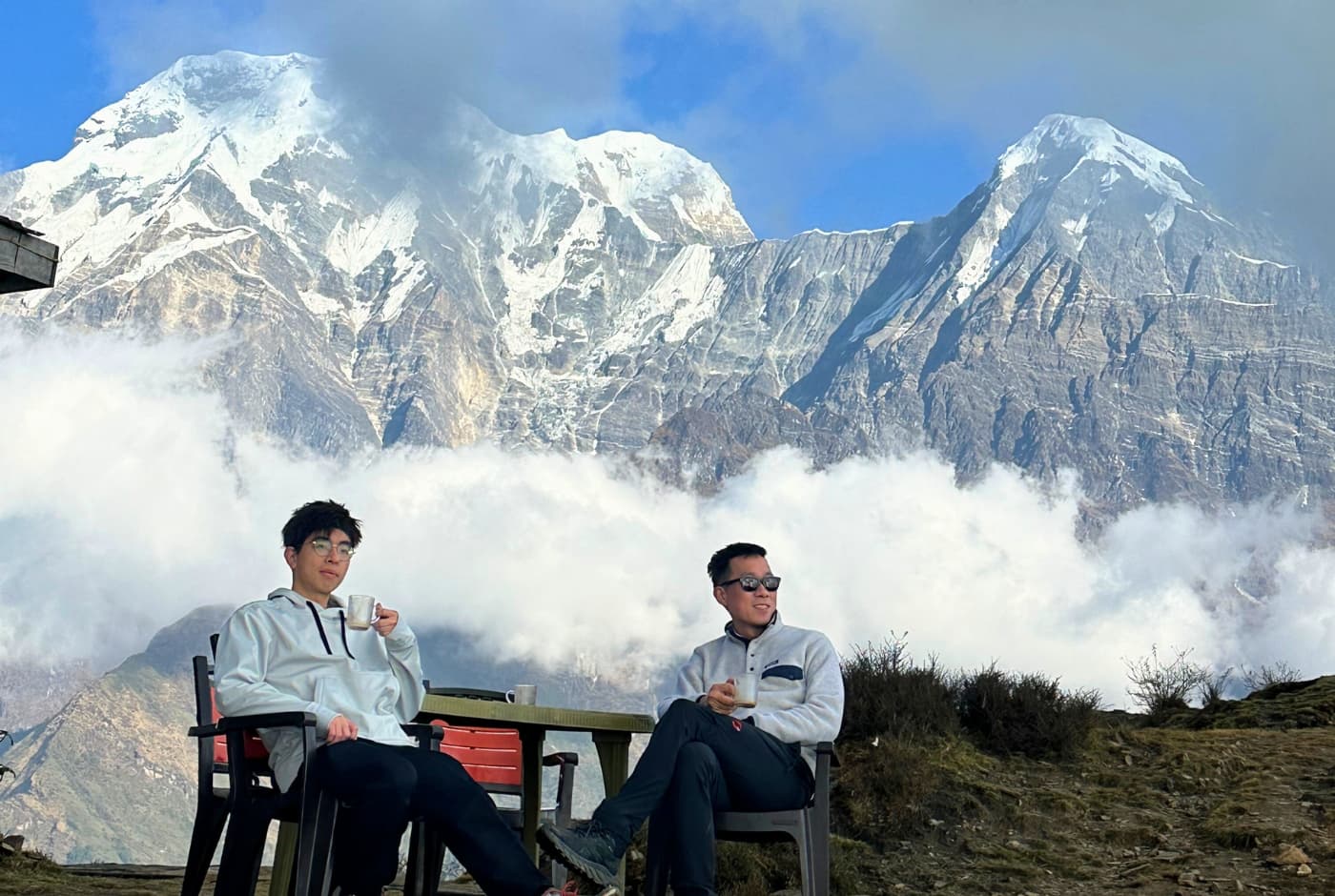
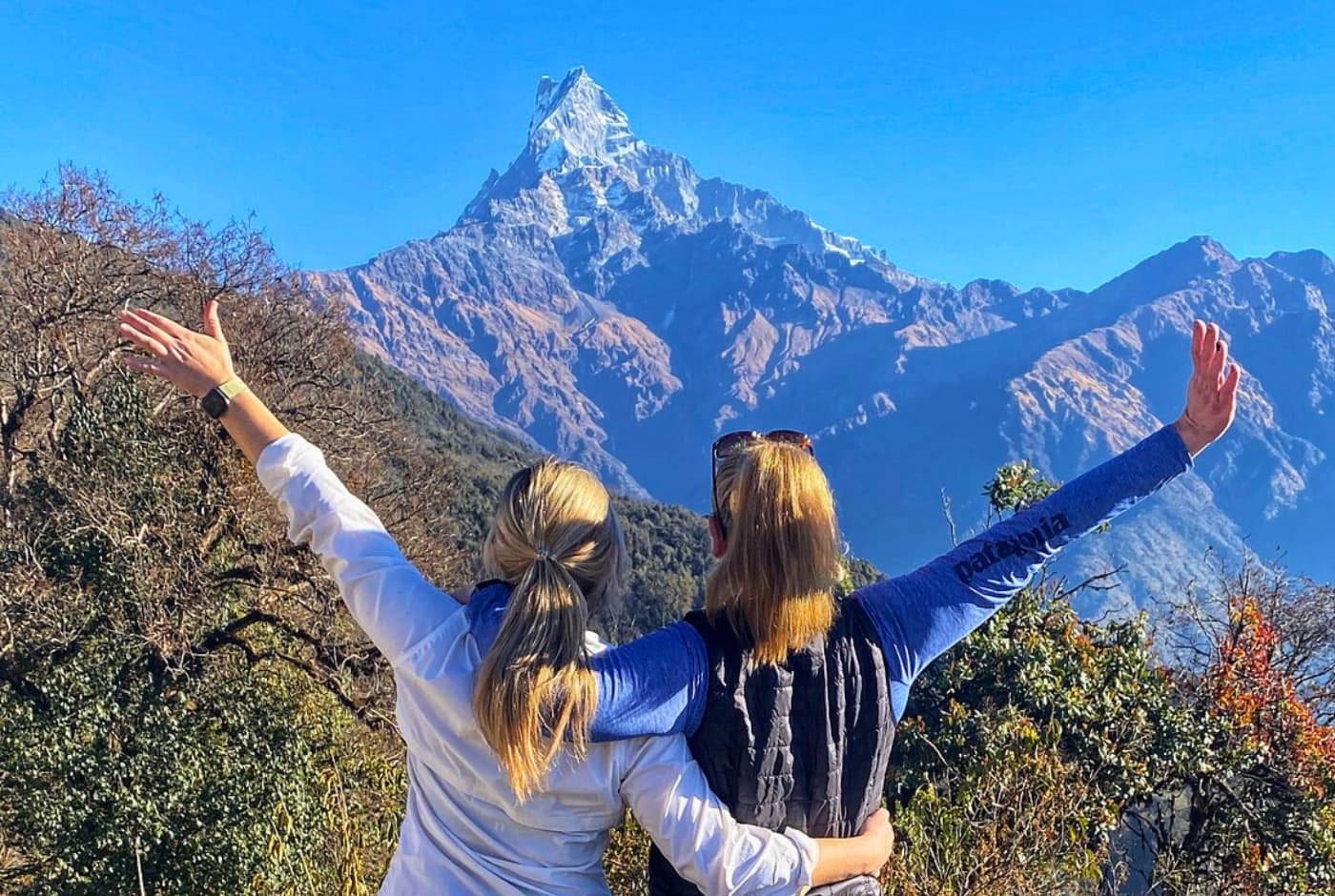
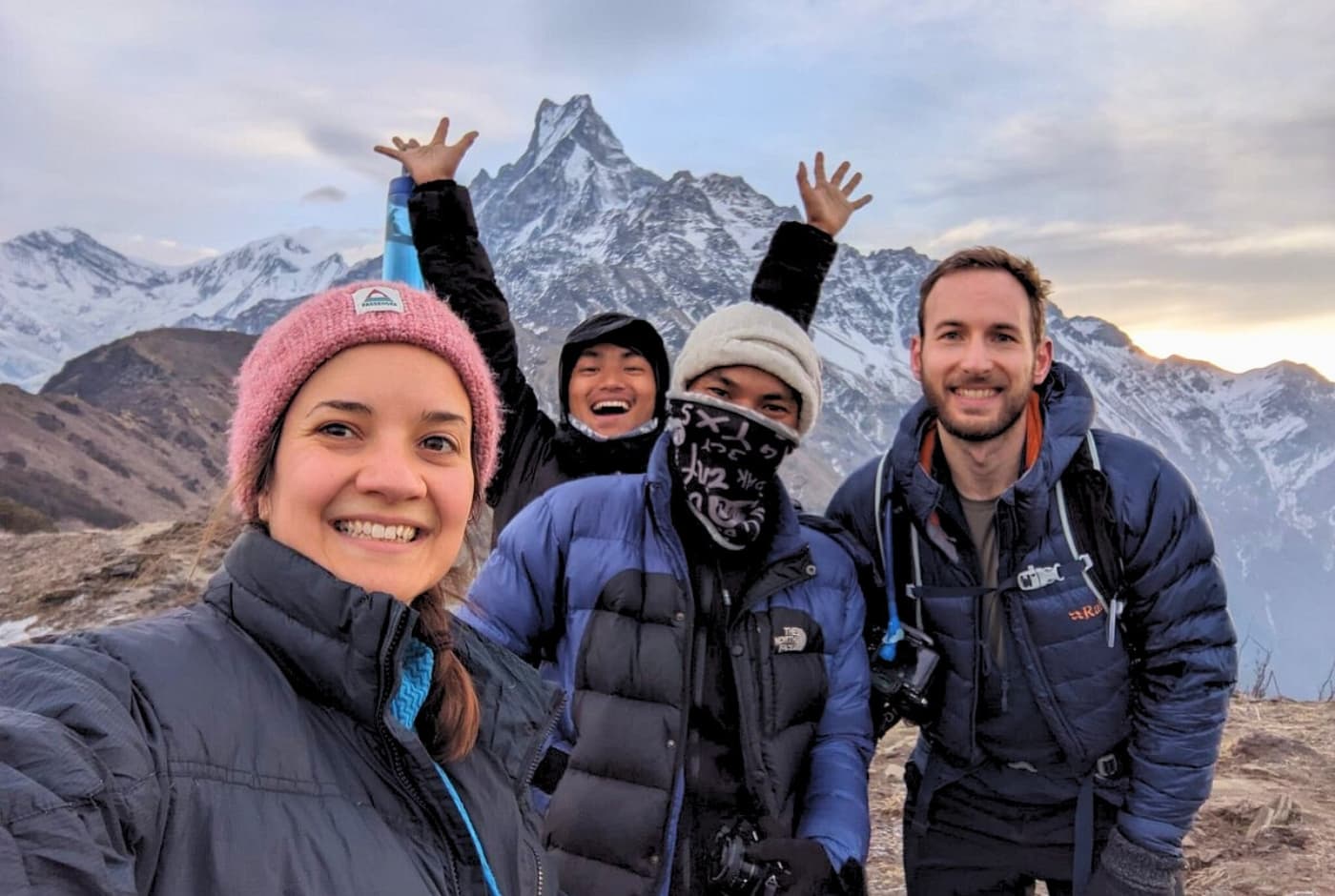

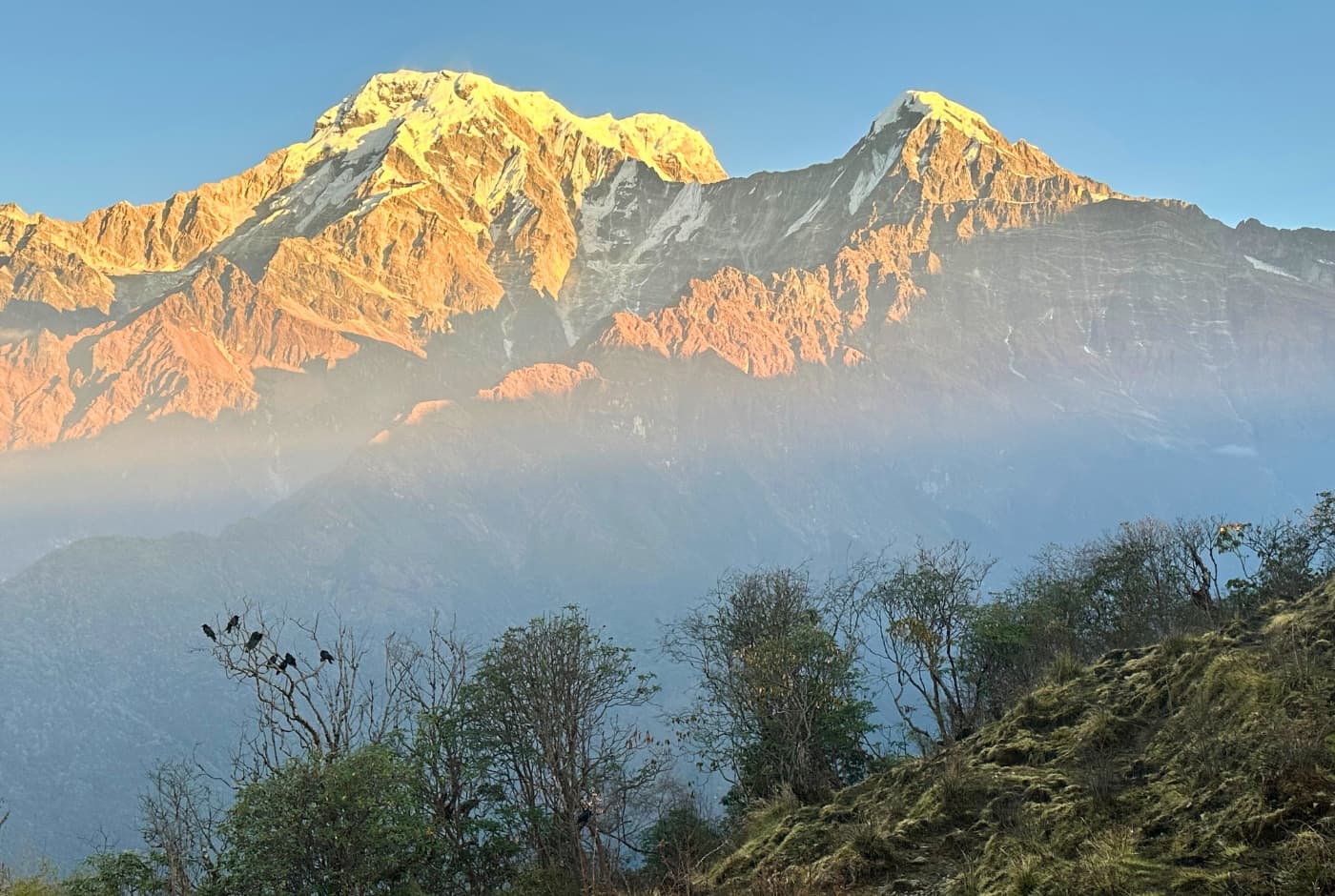
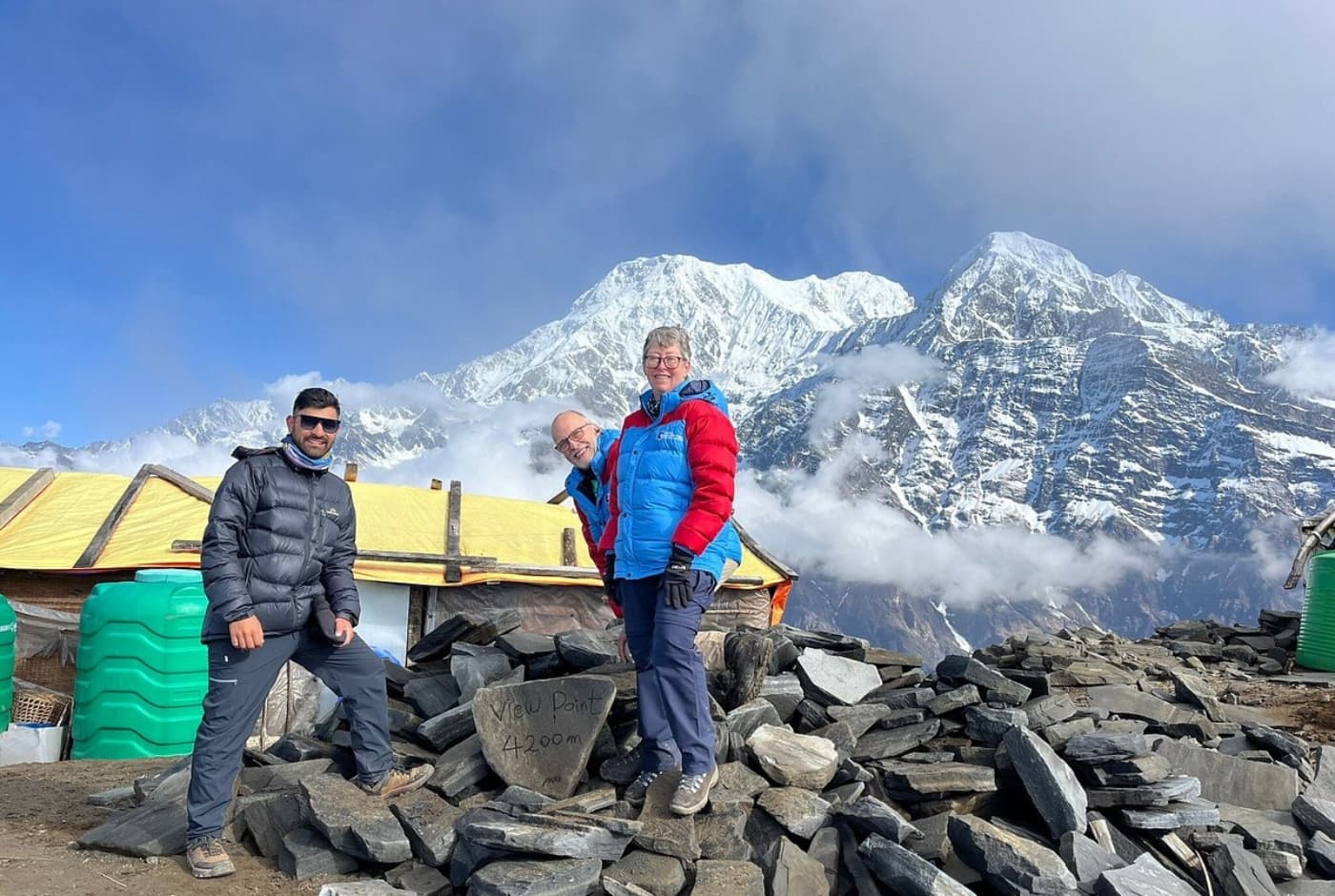

The Mardi Himal trek is a popular, short, and relatively easy-to-moderate trek in Nepal's Annapurna region, offering stunning views of the Annapurna and Machhapuchhre (Fishtail) mountain ranges, and accessible from Pokhara.
The Mardi Himal Trekking is a newly opened trek in Nepal (2012) that gained popularity quickly. It is a perfect option for the short-route trek in the Annapurna Region. This 8-day trek begins from Pothana (1990m) with a moderate-level Challenge and ascends to the Upper Viewpoint (4200m), near the Mardi Himal Base Camp.
Imagine walking alongside a lovely trail, savoring the beauty of the Annapurna without the hustle and bustle, and leaving footprints within the Annapurna landscape. You’ll be hiking through a diverse biodiversity, encountering mountain flora and fauna. You ascend to new heights and witness the elegant splendor of the mountains (Mardi, Machhapuchre, and other Annapurna ranges), valleys, and lush pine forests while being involved in their local culture.
Don't let this opportunity pass you by. Book your Mardi Himal Trek with us and experience the ultimate adventure. Our experienced guides will ensure that you have a fantastic time as you explore the gorgeous green hills and the White Mountains.
Are you ready to witness the magic of the Annapurna? Contact us now to book your trekking adventure.
Your arrival at the Tribhuvan International Airport (TIA) marks the beginning of the itinerary. One of our staff from NHT will greet you at the arrival gate. He’ll then take you to the hotel in Kathmandu. After a short briefing, you’ll have the rest of the evening to yourself.
After boarding the flight to Pokhara the next day, you’ll begin your Mardi Himal Trekking journey. Upon landing, you’ll drive to Dhampus and then trek to Deurali for an overnight stay. Deurali village serves as the midpoint of two famous trekking, Mardi Himal Trek and Annapurna Base Camp.
From Deurali, we ascend to Forest Camp/Kokar through the beautiful blend of forested paths. After staying for the night, you’ll go to High Camp, passing Low Camp.
Next comes the trek to View Point, the final destination of the Mardi Himal trek, and you’ll descend to Badal Danda. The final day of the trek brings a deep sense of achievement as you descend to Siding Village and push back to Pokhara. The flight back to Kathmandu marks the end of your journey to Mardi Himal Trek.
If you are wondering about the best time to book the trek, then you should consider scheduling your trip in either spring (March-May) or autumn (September-November).
These seasons offer ideal weather conditions and a perfect environment for trekking. The stunning landscapes and snow-capped mountains are at their best during these months. The trail is also filled with wildflowers, including the bloom of rhododendrons.
You can still enjoy the trek in winter (December-February) and summer (June-August). However, it's important to note that the possibility of snow and slippery trails can make the hike more challenging. So, it's better to plan your trek during spring or autumn for the best experience.
Determining whether the Mardi Himal Trek is right for you depends on a few factors, such as your physical fitness level and personal preferences.
The Mardi Himal Trek is an easy-to-moderate trek with a maximum altitude of 4,500 meters. It's suitable for trekkers of all ages with a reasonable fitness level. The trek is well-marked, and the trails are well-maintained, making it easier for novice trekkers to navigate. However, it's recommended to do some physical exercise and cardio workouts a month before the trek.
It is an 8-Day trek that involves long hours of walking through steep ascent and descent. The journey will give you a taste of the Annapurna region and leave you wanting more. Lastly, you do not need a trekking experience for this journey.
Following are the alternative adventures you can look at before choosing the perfect package for your holiday.
The first one is the Mardi Himal Trek package. It is a 9-day journey that follows the same itinerary as the Mardi Himal Trekking but adds a stay at Pokhara. This beautiful journey will take you through the lush green forest and to the High camp of the Mardi Himal. You can opt for this trek if you want to explore Pokhara.
The second one is the Mardi Himal Trek Via Poon Hill. It is a 12-Day journey that takes you to the High Camp of Mardi Himal via the Poon Hill route. At Poon Hill, you will wake up early to catch the beautiful sunrise and witness the panoramic views of the Annapurna range and other mountains. You can embark on this journey if you have enough days for your adventure.
No matter which trekking package you opt for, we guarantee an unforgettable vacation experience. Join us to witness the breathtaking beauty of the Himalayas firsthand.
When you arrive at TIA, a friendly face will greet you and transfer you to our hotel. You have a short brief of the journey. For the rest of the day, you may either stroll around the hotel or rest for the coming day's adventure.
Overnight stay at the Hotel.
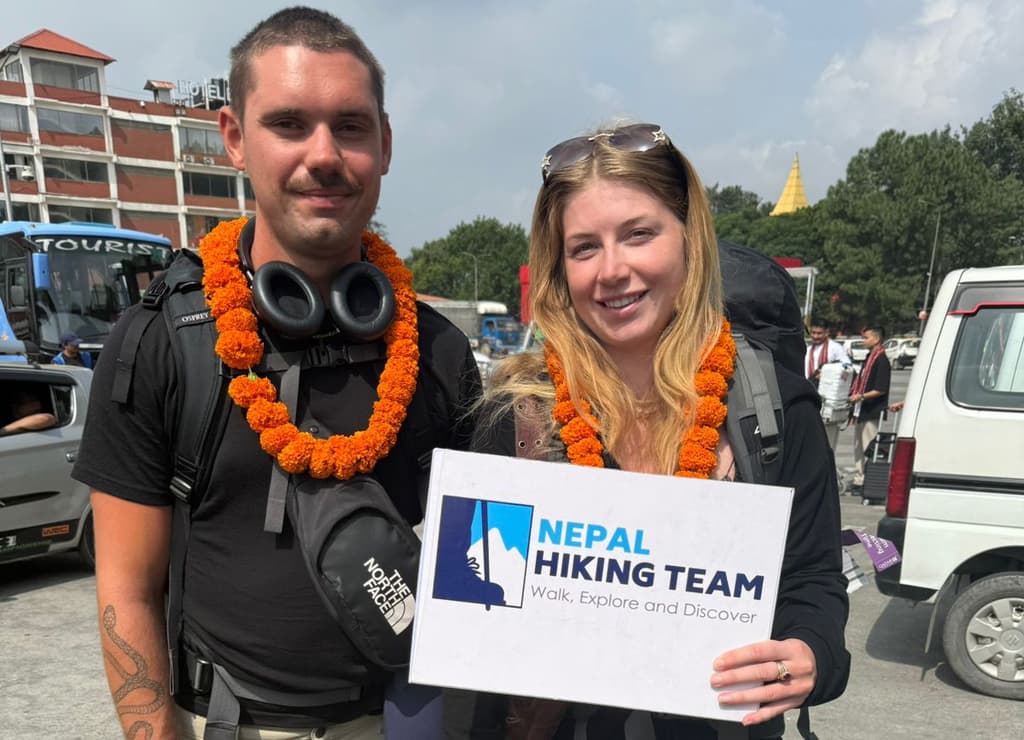
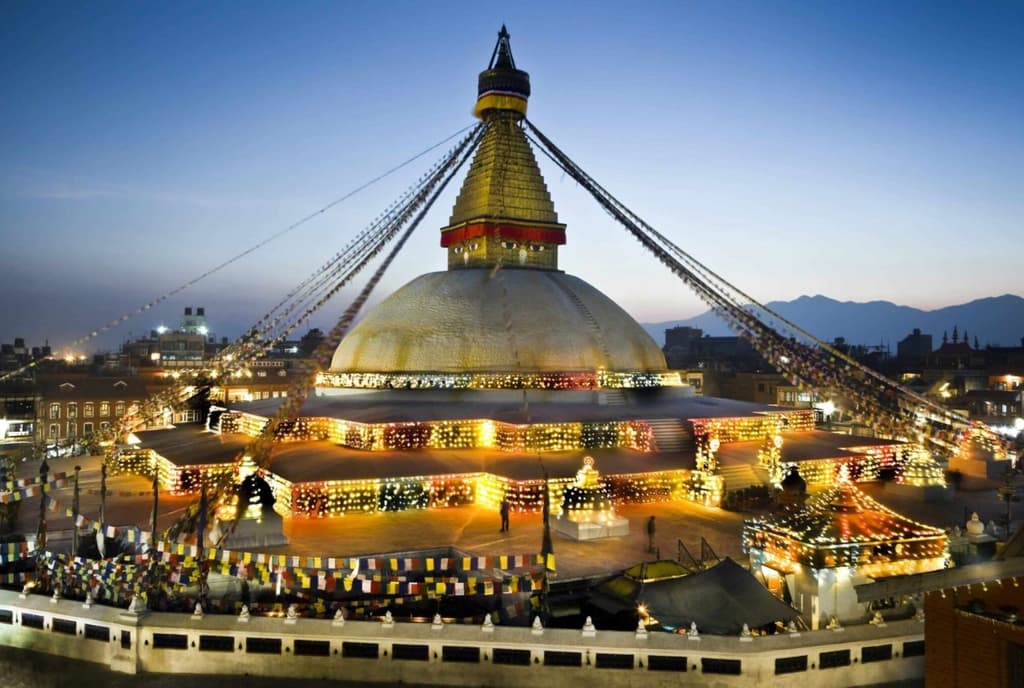
Your guide will pick you up to initiate the journey. You will then go to the airport to catch a flight to Pokhara, which takes about 30 minutes.
As you reach Pokhara, you will be amazed by the close-up view mountains. You take a 30 - 40 minutes drive to Dhampus Village and hike to Deurali. Stunning views of (Fishtail) Mt Machhapuchre can be seen if the weather permits.
On this fresh day, we start from Pitam Deurali and trek to Forest Camp, which leads through the quiet trail of oak, maple, rhododendron, and hemlock forests. If lucky, we can get glimpses of diverse wildlife like leopards, deer, monkeys, various species of birds, and others. We’ll reach Forest Camp through the Beautiful forests of pine and Rhododendron trees.
The trail continues from Forest Camp to High Camp through the dense forests. Ascending through the trails, we see rhododendrons and trees covered in moss and lichen. We’ll have lunch at Low Camp and enjoy the view of Mt. Machhapuchhre. Ascending from the Low Camp, the trail takes us west towards the fantastic views of Annapurna South and Hiunchuli Himal.
We’ll continue on the Mardi Himal ridge and see the beautiful rhododendron bushes. We might also see the colorful Danphe along the trail. We gradually arrive at High Camp, where we’ll see lodges bigger than Low Camp. The view from the lodge of Annapurna South, Hiunchuli Himal, and Mt. Machhapuchhre is phenomenal.
Accommodation: Overnight stay at the Guesthouse
Meals: Breakfast, Lunch, and Dinner
Wake up early to witness the legendary sunrise over the Himalayas. Then, we’ll have breakfast and begin climbing the Mardi Himal View Point at 4200m. This is one of the challenging days as we walk on the narrow and rocky trails. However, the view at the end of the trek makes all the hard work worth it. Mardi Himal is a sacred Himalaya of Nepal. The major highlight of this day is watching Nepal’s national bird, Lophophorus.
We descend steeply through farms and terrace fields following the same trail we went up. We then leave the trail and trek into the forest, heading to the Mardi Khola River. We descend further to Siding and then drive back to Pokhara.
Accommodation: Overnight stay at the Hotel
Meals: Breakfast
Today, at the late morning, we take a short flight to Kathmandu then transfer to hotel.
Overnight stay at the Hotel. Breakfast Included.
This is the end of your Mardi Himal Base Camp Trek. One of the representatives from the Nepal Hiking Team will drop you off at the airport 3 hours earlier to your flight. We bid you farewell as you take bags of memories of the trek.
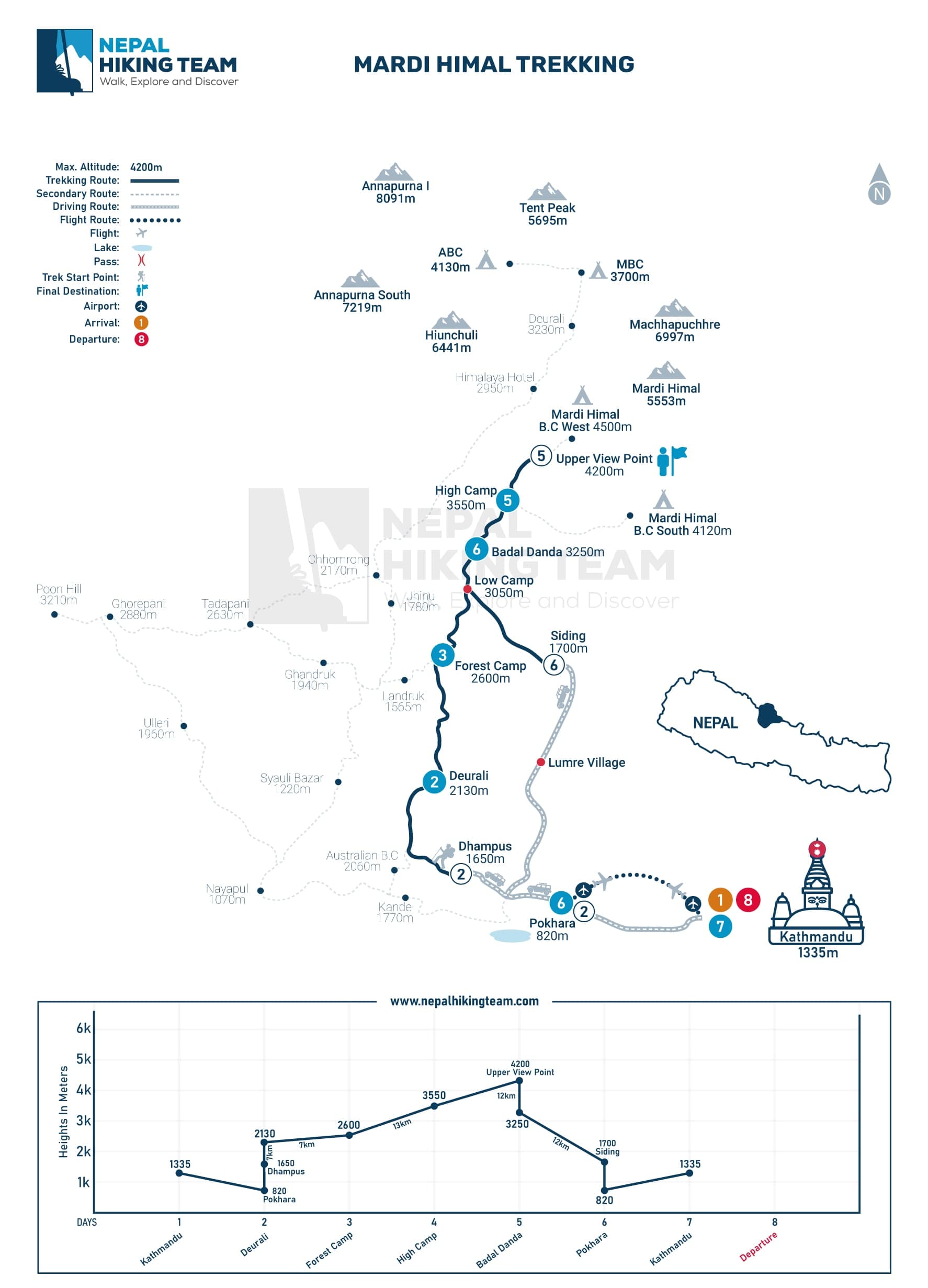
The Mardi Himal Trek is a popular short trek in Nepal's Annapurna region, offering a relatively easy and rewarding experience with stunning views of the Annapurna and Machhapuchhre (Fishtail) mountain ranges, and takes you to the Mardi Himal Base Camp.
Mardi Himal, standing at 5,587 meters (18,330 feet), is a striking peak in Nepal’s Annapurna region. Nestled within the Kaski District, it lies near the boundary of the Annapurna Conservation Area (ACA), approximately 25 kilometers (15.5 miles) north of Pokhara. This hidden gem sits beneath the iconic Machapuchare—also known as Fishtail—for its distinctive summit shape that remains unclimbed due to its sacred status. While Mardi Himal Peak soars high, the popular Mardi Himal Base Camp rests at 4,500 meters, offering panoramic views of the Annapurna Range and a quieter, less-traveled alternative to the region’s more crowded trekking routes.
The Mardi Himal Trek is generally rated as a moderate difficulty trek, making it ideal for trekkers with a decent fitness level and some prior hiking experience. While it's manageable for most active travelers, certain sections can feel demanding, especially for beginners. The journey reaches a maximum altitude of 4,500 meters at Mardi Himal Base Camp, with the trail gradually ascending over several days.
The Mardi Himal Trek typically begins with a short drive from Pokhara to Kande or Dhampus, a small village that serves as the starting point of the journey. From Kande, trekkers ascend gradually through rhododendron forests, traditional Gurung villages, and alpine landscapes, experiencing a steady change in scenery and elevation. The trek concludes at Siding Village, a peaceful settlement nestled in the lower hills, where most travelers opt for a return drive back to Pokhara.
The highest point reached during the trek is Mardi Himal Base Camp, situated at an altitude of approximately 4,500 meters (14,764 feet). However, it's worth noting that some itineraries identify the Upper Base Camp at 4,500 meters as the final viewpoint, while others consider the Lower Base Camp—located between 4,200 to 4,250 meters—as the official end of the trekking route.
The Mardi Himal Trekking in Nepal is a visually stunning and culturally rich adventure that showcases the best of the Annapurna region. From towering Himalayan peaks to vibrant forests and welcoming villages, the journey offers a balanced mix of nature, culture, and adventure.
The best time to trek Mardi Himal is during the shoulder seasons of spring (March to May) and autumn (September to November). These months offer the most favorable conditions—clear skies, stable weather, and fewer crowds—making for a more enjoyable and scenic trekking experience.
Pros:
Cons:
Pros:
Cons:
Pros:
Cons:
Monsoon/Summer (June to August)
Pros:
Cons:
The Mardi Himal trek, a popular short trek in Nepal's Annapurna region, typically begins with a scenic drive from Pokhara to either Kande or Phedi, located at around 1,275 meters. From here, the trail steadily gains altitude, offering a rewarding mix of forested paths, ridge walks, and mountain vistas. Early on, trekkers reach Pitam Deurali at 2,100 meters, followed by a gradual climb to Forest Camp, situated between 2,500 and 2,520 meters.
As the trek continues, the landscape opens up around Low Camp (3,035 meters) and Badal Danda, which ranges between 2,970 and 3,200 meters, providing increasingly dramatic views.
The route then leads to High Camp, perched between 3,580 and 3,660 meters, where most trekkers spend the night before the final push. From High Camp, it takes about two hours to reach the Mardi Himal Base Camp at approximately 4,500 meters (14,764 feet)—the highest point of the trek—with breathtaking panoramic views of the Annapurna range, including Annapurna South, Hiunchuli, and Machhapuchhre (Fishtail).
After enjoying the summit experience, the trail descends to Siding Village at around 1,885 meters, where the trek concludes with a return drive to Pokhara. While the maximum altitude is 4,500 meters, most overnight stays occur at or below 3,660 meters, allowing for manageable acclimatization along the way.
The Mardi Himal Trek offers trekkers an authentic Himalayan experience, with accommodations primarily in family-run teahouses that provide basic amenities and a glimpse into local culture. Here's a detailed overview:
Teahouses: These are the most common lodging options along the trek. Rooms are typically simple, featuring two or three beds with basic bedding. Shared bathrooms are standard, and while some teahouses offer hot showers, availability may be limited, especially at higher altitudes.
Shared Spaces: Teahouses often have communal dining areas equipped with wood-burning stoves, serving as cozy spots for trekkers to gather, share stories, and enjoy meals. These spaces foster a sense of camaraderie among hikers.
Menu Variety: Trekkers can expect a mix of traditional Nepali dishes and some Western options. Common meals include dal bhat (lentil soup with rice), pasta, momos (dumplings), and noodle soups. Breakfast might feature Tibetan bread, pancakes, or porridge.
Along the trail, family-run teahouses provide a variety of meals to keep trekkers energized. Here's an overview of what you can expect:
Staying in teahouses offers a unique opportunity to engage with local families and experience the region's culture firsthand. Many teahouses are family-owned, providing warm hospitality and insights into the daily lives of the mountain communities.
Altitude Considerations:
During peak trekking seasons, teahouses can fill up quickly. It's advisable to book accommodations in advance or arrive early at your destination to secure a room. In some cases, especially at higher altitudes, trekkers may need to share rooms or sleep in communal areas if space is limited.
Mardi Himal Trek requires obtaining two essential permits: the Annapurna Conservation Area Permit (ACAP) and the Trekkers' Information Management System (TIMS) card.
Purpose: This permit grants access to the Annapurna Conservation Area, encompassing the Mardi Himal region.
Cost:
Obtaining the ACAP:
Purpose: The TIMS card is designed to ensure the safety and security of trekkers by maintaining a record of trekkers' information.
Cost:
Additional Considerations:
Read our genuine feedback from past travelers with Nepal Hiking Team sourced from TripAdvisor, Google, Facebook, and Trustpilot.
We had an incredible experience with Nepal Hiking Team. From the very beginning, Gangaji was professional, warm, and thoughtful. He even arranging an extra team member to make sure we were comfortable and safe.
Paban (Group Leader) guided us brilliantly on both the Muktinath visit and the Mardi Himal Trek. Kamal (Assistant Leader), along with Bipin, Sabin, and Dipesh (Trekking Assistants), joined us on the Mardi Himal trek and were all patient, caring, and full of energy. Their teamwork made the journey unforgettable.
Back in Kathmandu, we stayed at Woodapple Hotel & Spa, perfectly located in Thamel, with spacious rooms and a rooftop restaurant that made exploring the city easy and enjoyable. We highly recommend Nepal Hiking Team to anyone visiting Nepal!
We recently joined Nepal Hiking Team for the Mardi Himal Trek and had an absolutely wonderful experience. On 6th–7th August we visited the sacred Muktinath Temple, then continued with the beautiful Mardi Himal Trek from 8th–11th August 2025.
Right from the start, communicating with the owner, Ganga ji, was a real pleasure. He is professional, kind, and very considerate. A great example of his thoughtfulness was when he arranged for a team of five members instead of four, just to make sure our group felt more comfortable and safe. That simple but meaningful decision showed the true care and dedication of Nepal Hiking Team.
Our trekking team was excellent:
Bipin, Sabin, and Dipesh (Trekking Assistants): lively, cheerful, and extremely caring. They carried our loads with ease and looked after us like family, making sure we were always comfortable and well taken care of.
The whole team went out of their way to give the five of us an unforgettable trip. Their skills, kindness, and genuine hospitality made the journey both enjoyable and memorable.
After returning to Kathmandu, we stayed at Woodapple Hotel & Spa, which was excellent. The hotel is right in Thamel, within walking distance of everything. The rooms are spacious with lovely views, and the rooftop bar and restaurant were the perfect spot to relax and enjoy the city. It was a wonderful way to end our trip.
I strongly recommend Nepal Hiking Team to anyone visiting Nepal and Mardi Himal Trekking. With Ganga ji and his amazing team, you can be sure of a safe, enjoyable, and truly memorable experience.
 +
+ +
+ +
+
We just finished a seven-day Mardi Himal trek with a guide and porter from Nepal Hiking Team.
Both were excellent—leading us along the trail, staying attentive, and being very pleasant throughout the trek.
Our guide was Netra Subedhi — a reliable and serious guide. He gave great advice, knew the area well, and could be fully trusted.
We changed the route several times during the trip, and he adjusted with a positive attitude to everything we asked for.
Highly recommended for this company for seven days, Mardi Himal!
A serious, professional company.
This company is a 10/10. Our guide Raj was phenomenal, and our assistant Gokul, porters Tuk, Ram, and Gokul, were amazing. I just can't say enough good things about them.
From the time we were picked up at the airport until we left. BEYOND helpful. They even kept one of our bags while we continued on to Bhutan and met us at the airport on the way back to retrieve it. They went above and beyond to help us.
I would HIGHLY recommend this company. Professional, knowledgeable, and accommodating. And our team was the best of the best.
Thank you for making our trip to Mardi Himal so amazing.
After a two-month journey across Asia with a friend, I landed in Kathmandu to meet my family for our Mardi Himal. From the airport pickup to our final drop-off, the Nepal Hiking Team delivered a flawless experience.
Our guides were exceptional—well-versed and well-organized, yet they allowed us the flexibility to enjoy a non-linear adventure. The trek itself was remarkable and remains a cherished memory.
Mardi Himal is located in the Annapurna region of Nepal, specifically in the Kaski District, just beneath the prominent Machhapuchhre (Fishtail) mountain, and is a popular trekking destination.
The Mardi Himal Trek can be completed in 8 days including travel to and from Kathmandu, with 5 days dedicated to trekking and reaching the highest point at 4200m.
The Mardi Himal trek is a popular choice in the Annapurna region for its relatively short duration, moderate difficulty, and stunning views of iconic peaks like Annapurna and Machhapuchhre, along with diverse landscapes and cultural experiences.
Yes, the Mardi Himal Trek is generally considered suitable for both beginners and experienced trekkers due to its well-maintained trails, manageable daily distances, and the availability of teahouse accommodations. The trek offers a relatively short duration and well-marked trails, making it accessible for those with limited trekking experience. The trek also provides a good challenge for experienced trekkers, with opportunities to reach the Mardi Himal Base Camp at 4,500 meters (14,764 feet) and enjoy stunning views of the Annapurna and Machhapuchhre mountains.
Booking with us is an easy, hassle-free process.
Any confusion? Feel free to contact us- we'll reply with a clear solution.
To cancel your trip, all you have to do is send us a trip cancellation request. And then we will proceed with your cancellation process.
As for the refunds, we apologize for informing you that 20% of the deposit made to confirm your booking will not be refunded. This amount will be considered a cancellation fee.
We strongly encourage our clients to postpone the trip to the upcoming days (without losing a penny) rather than cancel the trip. Choose a convenient date, and please inform us 2 weeks before your trip departure date.
Yes, most nationalities can. Fill out the online form before arriving in Nepal. Bring a passport with six month's validity and blank pages(for visa stamp).
Please remember that some nationalities – Nigeria, Ghana, Afghanistan, and others – must apply in advance. For detailed information about Visa, visit our blog section of Visa Information.
Yes, a representative from Nepal Hiking Team (NHT) will be at Tribhuvan International Airport (TIA) to pick you up and escort you to your hotel, holding a sign with "Nepal Hiking Team".
Yes! Travel insurance is mandatory and should cover high-altitude trekking (over 4000m) and emergency evacuations. Other things, such as accidents, injuries, and hospital bills, should also be covered.
No mandatory vaccinations are required, but CDC highly recommends a few: hepatitis A and B, typhoid, polio, tetanus, and measles (if you are not already vaccinated) depending on the season and travel plans. If you have any medical conditions, please inform us when booking.
Always consult your doctor or a travel clinic for personalized advice and the most current recommendations, as travel health guidelines can change.
Yes, you can buy a SIM card at Kathmandu's Tribhuvan International Airport (KTM). It's the fastest and easiest way to get a SIM card in Nepal.
There are booths for major cell phone companies like NCELL and Nepal Telecom in the arrival hall and near the baggage claim area. If required our NHT staff can help you make your choice and provide information.
Our 8-day package includes a centrally located 3-star hotel in the Lakeside area of Pokhara. Whereas for Kathmandu, you will stay in a 3-star hotel, namely WoodApple and Spa or any similar hotel.
Yes, you can leave your luggage at your hotel in Kathmandu while you are on a trek in Nepal. Hotels offer luggage storage facilities for guests going on treks, usually at no extra charge (free service). You can take it back after returning from the trip.
Pack light: Only take what you need for the trek and leave unnecessary items at your hotel.
During the Mardi Himal trek, you'll primarily find accommodation in basic, locally-run "teahouses" or lodges, offering simple but comfortable rooms with mattresses, pillows, blankets, and sheets.
These are small, family-run establishments that offer basic but adequate accommodation, including rooms with mattresses, pillows, blankets, and sheets.
You can expect basic amenities like hot showers, Wi-Fi, and phone charging points in some teahouses but at additional costs.
If you want to extend your stay in Kathmandu or Pokhara, we're happy to help. We'll arrange the stay; the rates may vary according to the hotels.